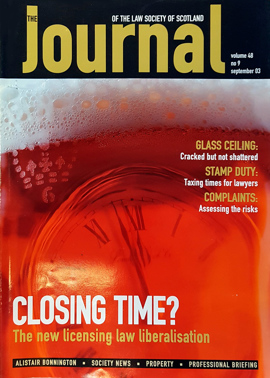Book reviews
I received this book with a mixture of emotions. I was touched by the Editor’s faith in me but hardly enamoured of his choice. However, its 300 or so pages, proved a surprisingly easy read.
The Law Society of Ireland celebrated its 150th anniversary last year. This book is the history of the Society and of the profession.
Much of the history of Irish solicitors before secession was very similar to that of England. As in the rest of Britain, the conveyancing monopoly was introduced in the early 19th century in return for the much-resented stamp duty solicitors then had to pay on their annual practising certificates.
In many ways, the Irish profession has been more advanced than ours. In 1893, the Northern Law Society adopted a standard form of general conditions of sale, “each solicitor inserting the special conditions required in each case”. What common sense! More recently, the Solicitors (Amendment) Act 1994 obliges each solicitor to provide his clients in advance with written particulars of the charges to be made. More common sense.
A more important difference, perhaps, is the grip that the Law Society has had for many years on solicitors’ education. In 1967 the Society established a full-time law school, solicitors being educated on a “sandwich” basis through a six-month professional course, 18 months in the office, then an advanced course in the law school, with an emphasis on “learning by doing”. In 2000, a new £5 million Law School was opened to educate all the students. The Society is the direct and exclusive provider of professional courses. The performance of apprentices is assessed by exams, work assignments and performances in tutorials. The Society also maintains a library, an important asset particularly for smaller and medium sized firms and the law school students. However the Irish have only recently introduced an annual requirement for 12 hours’ CPD.
The chapter on the emergence of women in the profession is fascinating, drawing comparisons with other parts of the English-speaking world. After many battles, the first Irish woman students were admitted in 1920 and the first solicitor in 1923. Ever in the van, the Irish elected their first female President in 1980.
One aspect of the book was profoundly unsatisfying. The treatment of the struggle for Irish independence and the effect it had on solicitors and their profession is slight. How fascinating it would have been to have read about the ways in which solicitors maintained professional independence when families divided against each other, or in providing advice to people accused of treason. Again, independence led to two decades of economic stagnation, dominated by entrenched interests and infighting, and the strains on the profession are only hinted at. There’s a great story in there struggling to get out.
Although the profession in Ireland is obviously in good heart. it is certainly not without challenges. In a final chapter, Ken Murphy, Director General of the Society, deals with public demands for competitiveness. He says: “a tension has emerged between the values of lawyers and the legal system, where the emphasis is placed on justice and the rights of individuals, and the values of competition policy, with its emphasis on economic efficiency in the delivery of goods and services to consumers”.
We all recognise that tension.
John Elliot
In this issue
- The truth is a terrifying commodity
- Last orders for drinks licences as we know them
- Inside the Nicholson Report
- The room at the top
- To protect and serve
- All change for stamp duty
- Get an honest day’s work for an honest day’s pay
- Facing up to threats of action – and learning
- How to make other people run your IT smoothly
- Client care goes live
- Praise on anti-money laundering efforts
- Sheriff’s notes not recoverable
- Restoration or castles in the air?
- Marquess of Queensberry rules
- Website reviews
- Book reviews
- Conveyancers asked to order early reports






